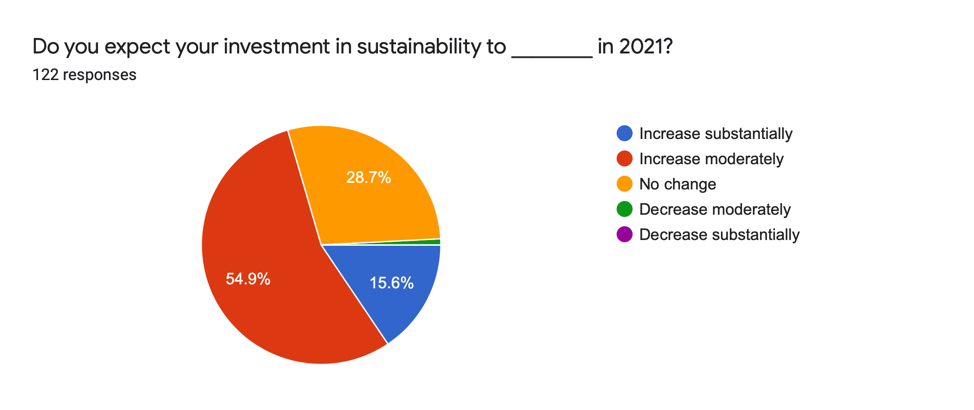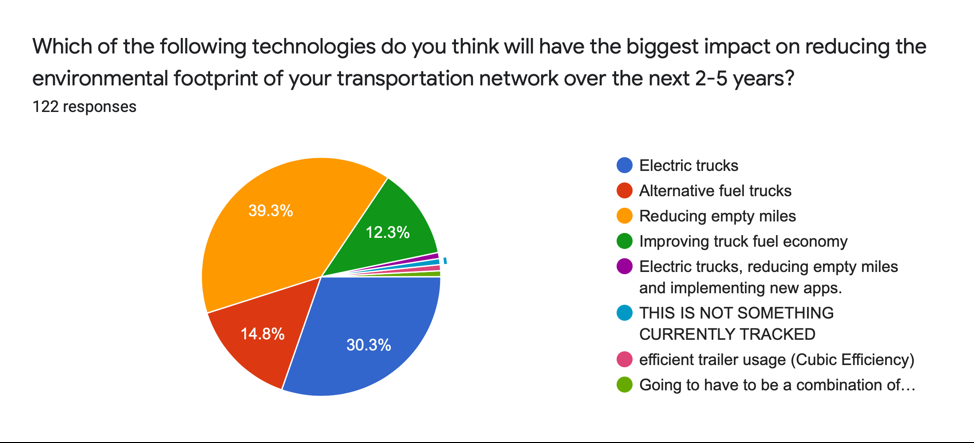We live in a world where the transportation of people and goods accounts for approximately 25% of all energy consumption. Transportation is an industry that relies heavily on diesel fuel to deliver goods from manufacturers to consumers around the world. The problem is that diesel consumption is one of the top pollutants for the environment and is not a sustainable solution for businesses transitioning to cleaner supply chain practices. The challenge is there is no single solution or alternative to solve this problem even when transportation leaders are expecting to increase their investment in sustainability in 2021.

In a recent survey to 122 transportation leaders, 84% of respondents expect their investment in sustainability to increase in 2021.
While technology has been instrumental in reducing the number of empty miles from trucks today — which accounts for 35% of the carbon emission emitted — alternative fuel vehicles, including biodiesel and electric vehicle (EV) trucks, present additional pathways for eco-conscious companies to reduce the environmental impact of their supply chain. In reality, there are still numerous challenges to overcome before diesel is ultimately rendered obsolete. Today, alternative fuels remain a narrow niche available only to the largest fleets due to the high cost, which is often passed to customers. Of the 1 million carriers in this country, the majority are owner-operators with small fleets who won’t immediately be able to adopt these fuel alternatives.
The vast majority of trucks on the road today are powered by diesel for a variety of reasons. Diesel is relatively cheap and convenient. Trucks can be fueled rapidly, run long distances, maintain inexpensive onboard storage, are less expensive to purchase, have access to a readily available fuel supply, and widespread service and support is easily available. New regulations and consumer demand, however, are pressuring the industry to adopt cleaner fuel practices.
Alternative fuels need to be a practical option in order to drive universal adoption in trucking. The reality is there needs to be more strategic business benefits outside of environmental sustainability for most companies to invest in alternative fuel trucks. Alternative fuels must clearly demonstrate there is a positive environmental and/or social impact while improving the bottom line at the same time.
Alternative fuels can reduce greenhouse gas (GHG) emissions, but today they have a limited use case and are expensive. No alternative fuel type today is currently able to support long-haul trucking, which is the most wasteful type of transport. Alternative fuels also have a host of operational challenges, including limited public infrastructure, higher vehicle costs, and limited service and support. Perhaps most importantly, all of these alternative fuel vehicles are not readily accessible to 90% of the trucking industry. Of the 1.2 million trucking companies in the U.S., 90% are small fleets with fewer than a half dozen trucks. Only the largest fleets are incentivised to invest in alternative fuel today.
Alternative fuels which have the potential to be used in trucking include biodiesel, gasoline, electric trucks, natural gas, and hydrogen fuel cells. Gasoline is the most commonly used of these alternatives and represents about 10% of fuel used by medium and heavy-duty trucks, according to the Department of Energy. However, for many heavy-duty trucks, and particularly for long haul trucking, diesel remains the more sustainable and efficient fuel.
About 5% of diesel fuel consumed in the U.S. is biomass-based, or biodiesel, according to the EIA. While biodiesel does produce fewer emissions from the tailpipe, there is mixed evidence about the life cycle impact of biofuels, as significant land and energy are required to create the bio-based additives in the fuel. Biodiesel is also more expensive and relies on government subsidies to compete with the price of regular diesel.
While electric trucks do indeed have the potential to significantly decrease carbon emissions from trucking, the technology is in a nascent stage and is not yet affordable under current market conditions. Additionally, the infrastructure and grid capabilities needed to charge heavy-duty trucks does not yet exist and will require massive investment before practical use. And electricity for much of the country is still from coal. Natural gas and hydrogen fuel cell-powered trucks face many of the same challenges, have not been widely tested, and are many years, if not decades, away from widespread use.
Enterprise businesses are purchasing alternative fuel trucks to benefit from reduced operational costs and carbon emissions. The reality remains, however, that small trucking companies simply can’t afford to make the same level of investment in new vehicles when most operate paycheck to paycheck. State and nationwide policies, in addition to incentives, are needed to create realistic support for the adoption of alternative fuel vehicles in trucking. As an industry, we want to avoid the situation where sustainable options are only available to the biggest corporate trucking companies. Too often, this means the most sustainable choices are only an option for the biggest corporate trucking companies.
When you consider the most pragmatic solution for reducing carbon emissions in the trucking industry, the reality is fleets will move freight in a zero-emissions world when it is both profitable and efficient. Until these problems have been resolved, the widespread use of alternative fuels will remain one of those trucking industry trends that is always “just ahead of us.” This doesn’t mean the switch will never happen, but most of the professional drivers on the road today might very well retire before the necessary changes take place.
In the meantime, we are still faced with the massive dilemma of inefficiency in trucking and our environment is paying the price. The window to take action against climate change is closing. Reducing empty miles is a priority that all transportation leaders should incorporate into their network strategy. It’s not only good for the environment but often also the bottom line.

40% of transportation leaders believe that reducing empty miles will have the biggest impact on reducing
the environmental footprint of their transportation network in the next 2-5 years.
Reducing empty miles means drivers don’t have to invest in a new truck right now, but they can continue earning while reducing emissions in a way that is not disruptive to their day-to-day operations. In an ideal state, drivers can eliminate the 35% of miles driven empty, which translates to lower shipping rates because drivers aren’t driving non-revenue miles as often.

Recent Comments
While it may seem as short as one...